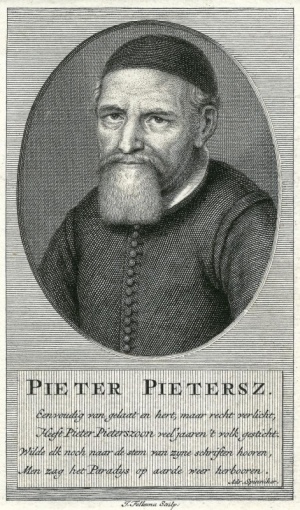Pietersz, Pieter (1574-1651)
Pieter Pietersz (German, Peter Peters), called "de Oude" (Senior), was born at Alkmaar on 28 January 1574, died 14 October 1651, at Oost-Zaandam, was a Dutch Mennonite preacher, serving in the Waterlander congregation of De Rijp about 1600-1625, and then until his death in the Waterlander or "Komenjannen" congregation at Zaandam. He was a friend of the Waterlander leader and elder Hans de Ries, and sided with him in the dispute with Nittert Obbes and Jan Theunis. Pietersz is said to have been a gentle, peace-loving, pious man, averse to doctrinal strife: for more than fifty years he worked with unusual effectiveness in the office of preaching. He was a carpenter or rather a maker of windmills and had no special theological training. On 25 May 1627, after he had preached his sermon at Markenbinnen, he was compelled to dispute with the Reformed minister Abdias Widmarius, who accused him of Socinianism. During his ministry at De Rijp, Pieters had some disagreement with his co-preacher Jan Willems, caused by views on dogma as well as by personal differences.
Pietersz wrote a number of devotional books, tracts, and sermons. His best-known book is Wegh na Vreden-stadt: waer in ghewesen wordt hoemen die Vrede mach bekomen (Way to the City of Peace, in Which is Shown How to Obtain Peace), followed by a prayer and some hymns. This book, written about 1625, went through eight Dutch editions, most of which were undated (nearly all editions now lost). It is a remarkable book, depicting in dialogue form the itinerary to the "heavenly Jerusalem," where is found "the unity of spirit under the palms of peace." "No doubt Wegh na Vreden-stadt is a book of fine Christian spirit and moralism. Yet its spirit is far different from all that is known in earlier Mennonite literature, and the book certainly deserves the honor of being one of the very first pietistic writings in Dutch Mennonitism" (Friedmann). Both in method and spirit John Bunyan's Pilgrim's Progress (1678) may have been inspired by Wegh na Vreden-stadt.
Besides this book Pietersz published Twee Een-voudighe stichtelijcke Predicatien . . . (Amsterdam and De Rijp, 1624); Toetz-steen om te proeven elck mensche de wegh sijns levens (De Rijp, 1629); Spiegel der Gierigheydt (Hoorn, 1638; 9th ed., 1698); Hemelsche Bruyloft (De Rijp, 1641; Amsterdam, 1642 and 1662); Spieghel der Bermherticheyt (De Rijp, 1645), followed by Proeve des Waren Christelycken Geloofs and Een Christelijcke Sendtbrief aen alle Doopsgezinden; Predicaties over de Liefde (De Rijp, 1642), a sermon on the Foolish Virgins and some other sermons. A sermon on the Song of Solomon 2:1-6, "Stichtelycke Predicatie van de Bloem te Saron," is found in Kort-Verhael van het leven en de Daden van Hans de Ries (De Rijp, 1644). Finally Pieter Pietersz' Opera (Complete Works) were published in Harlingen, 1651 (reprinted Amsterdam, 1666, no place of publication indicated, but between 1675 and 1686, 1698, 1715, and 1740).
Pietersz' works not only were eagerly read both by Mennonites and non-Mennonites in the Netherlands, but they also have been very popular among the Mennonites of the Palatinate, Prussia, South Russia, and also in America, where they were imported by the Russian Mennonites, especially the Kleine Gemeinde in 1874. For this purpose they were translated into German in the early 18th century and maybe even before, but all these old editions are apparently lost. The following editions in German are known: Weg nach Friedenstadt (1790); Spiegel der Gierigkeit (1827); Spiegel der Barmherzigkeit (1865); Ein Christlicher Sendbrief (1865); Ausgewählte Schriften von Peter Peters . . . für die Liebhaber der Wahrheit aufs Neue aufgelegt (Stuttgart, 1865; reprinted Elkhart, 1901); the American edition also contains a translation from the Dutch of the Toetz-steen under the title Prüfstein der Menschheit, um für jedermann zu prüfen den Weg seines Lebens, ob er recht gehe nach der Stadt des Friedens, oder hingehe nach Unfrieden und Jammer. Pietersz' tract, Himmlische Hochzeit, translated by the translator of Prüfstein, appeared in America in 1906.
Bibliography
Amstelodamum Yearbook XXV (1928): 96, 97, 98, 119, No. 51.
Doopsgezinde Bijdragen (1863): 122; (1864): 15; (1896): 18-26; (1900): 90; (1907): 49 f.; (1917): 30-32.
Friedmann, Robert. Mennonite Piety Through the Centuries. Goshen, 1949: 106-11.
Hege, Christian and Christian Neff. Mennonitisches Lexikon, 4 vols. Frankfurt & Weierhof: Hege; Karlsruhe: Schneider, 1913-1967: v. III, 354.
Kühler, Wilhelmus Johannes. Geschiedenis van de Doopsgezinden in Nederland: Gemeentelijk Leven 1650-1735. Haarlem: H.D. Tjeenk Willink & Zoon, 1950: 171-74, 176, 202.
Mennonite Quarterly Review XIV (1941): 188.
Mennonitischer Gemeinde-Kalender 1930.
Schagen, M. Nammlijst der Doopgezinde Schrijveren. Amsterdam, 1745: 80f.
Schijn, Hermann. Geschiedenis dier Christenen, welke in de Vereenigde Nederlanden onder de Protestanten Mennoniten genaamd worden . . . Tweede Druk op nieuws uit het Latyn vertaald, en vermeerdert door Gerardus Maatschoen, 3 vols. Amsterdam: Kornelis de Wit, 1743-45. 1744: v. II, 588-96, with a picture of Pieter Pietersz.
| Author(s) | Christian Neff |
|---|---|
| Nanne van der Zijpp | |
| Date Published | 1959 |
Cite This Article
MLA style
Neff, Christian and Nanne van der Zijpp. "Pietersz, Pieter (1574-1651)." Global Anabaptist Mennonite Encyclopedia Online. 1959. Web. 21 Nov 2024. https://gameo.org/index.php?title=Pietersz,_Pieter_(1574-1651)&oldid=162213.
APA style
Neff, Christian and Nanne van der Zijpp. (1959). Pietersz, Pieter (1574-1651). Global Anabaptist Mennonite Encyclopedia Online. Retrieved 21 November 2024, from https://gameo.org/index.php?title=Pietersz,_Pieter_(1574-1651)&oldid=162213.
Adapted by permission of Herald Press, Harrisonburg, Virginia, from Mennonite Encyclopedia, Vol. 4, pp. 175-176. All rights reserved.
©1996-2024 by the Global Anabaptist Mennonite Encyclopedia Online. All rights reserved.

